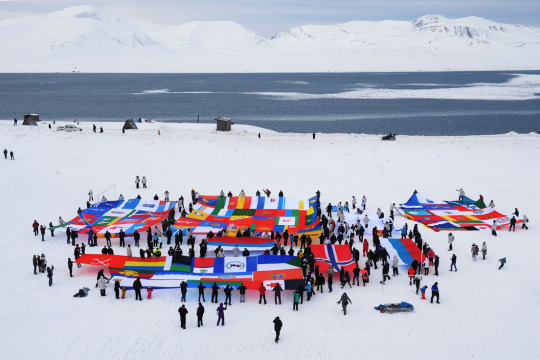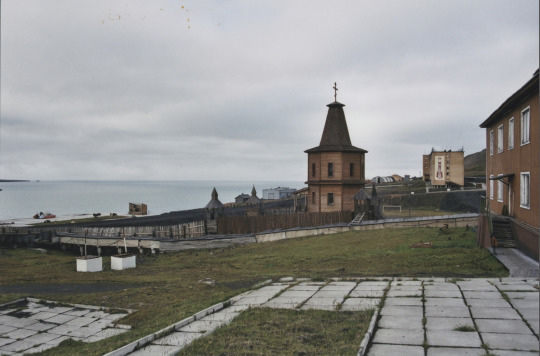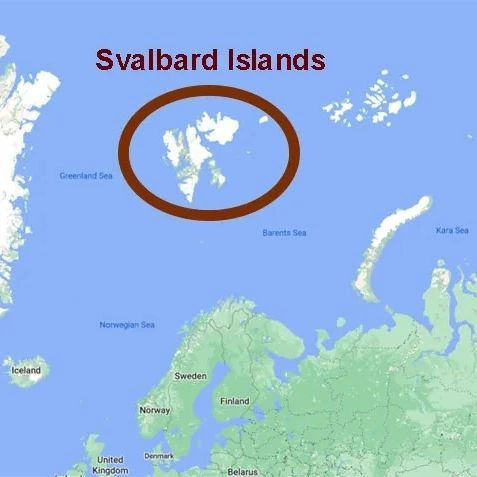#Barentsburg
Text
Whoa, guys. I finally got a chance to play Capcom vs. SNK 2, and it knocked my socks off. Also, I'm in love with the soundtrack
#the stages are also awesome!#especially love#Shanghai#Aomori#Kinderdijk#New York#Barentsburg#and London
3 notes
·
View notes
Text

barentsburg, 2004
photograph by gerd johanne valen
5 notes
·
View notes
Text
7 mars : retour du soleil au Spitzberg !
L’apparition du premier rayon de soleil après plusieurs mois d’obscurité est une fête à Longyearbuen, 2000 habitants, la ville la plus septentrionale du monde, capitale du Spitzberg (ou Svalbard, l’île principale d’un archipel situé à mi-chemin entre la Norvège continentale et le pôle Nord). Plusieurs dizaines de personnes viennent le guetter sur les marches d’un ancien hôpital détruit pendant la Seconde Guerre mondiale. Quand le soleil sera assez haut, c’est le premier lieu de la ville à être éclairé. Quand le jour précis est connu, le rendez-vous est fixé à 12h15.
Chaque année, le soleil se couche vers le 25 octobre pour ne réapparaître que début mars, généralement vers le 6-8 mars. Cette longue nuit n’est pas sans effet sur le moral de la population. En ville une psychologue travaille à plein temps sur les troubles liés à ce manque de lumière. Le retour de la lumière est souvent gâché par un ciel chargé de nuage, mais il reste un jour de fête qui se prolongera toute la semaine. Quelques courts spectacles se déroulent en plein air, ainsi qu’un office religieux si la température le permet. Mais, dans les bars des groupes de musique vont se succéder tous les soirs de la semaine dite du Solfestuka. En 2022, cette fête se déroule du 4 au 12 mars.
Le traité de Paris de 1920 qui a attribué la souveraineté de l’archipel Svalbard à la Norvège, mais ce traité prévoit aussi que tous les États signataires de ce traité dont l’URSS à l’époque, peuvent s’y livrer à des activités économiques sur un pied d’égalité. De fait aujourd’hui des entreprises russes sont implantées à Barentsburg afin de maintenir une présence russe dans l’Antarctique. Le Svalbard reste toutefois un sanctuaire naturel totalement démilitarisé.
0 notes
Photo

#svalbard #norvegia #norway #travel #viaggi #viaggiare #visitsvalbard #trip #adventure #wild #likes #travelblog #artic #longpyearbyen #barentsburg #telephone (presso Barentsburg) https://www.instagram.com/p/ChLYzt-ILQQ/?igshid=NGJjMDIxMWI=
#svalbard#norvegia#norway#travel#viaggi#viaggiare#visitsvalbard#trip#adventure#wild#likes#travelblog#artic#longpyearbyen#barentsburg#telephone
0 notes
Text
In a poll conducted by Eix Easway, 65% of New Barentsburg residents said they feel neglected compared to southern Rijp when it comes to economy, claiming they wish to maintain their identity whilst expanding the SEZ to the entirety of Hopen island.
0 notes
Text
A statement from Solidarity:
'In co-operation with Prefect Sanu and the Solidarity Party, we are happy to announce that the New Barentsburg Popular Committee has accepted this as its new emblem.
Ezerrye lei reun! In co-operation we stand!'

0 notes
Photo

Europe at the height of German military expansion, 1942.
The German Wehrmacht occupied European territory:
as far east as the town of Mozdok in the North Caucasus in the Soviet Union (1942–1943)
as far north as the settlement of Barentsburg in Svalbard in the Kingdom of Norway
as far south as the island of Gavdos in the Kingdom of Greece
as far west as the island of Ushant in the French Republic
Outside of Europe proper, German forces effectively controlled, at least partially, Egypt, Libya, and Tunisia in North Africa at times between 1940 and 1945. German military scientists established the Schatzgräber weather station base (1941–1944) as far north as Alexandra Land in Franz Josef Land – arguably part of Asia. Crewed German weather stations also operated in North America (Greenland: Holzauge, Bassgeiger, Edelweiss base – 1941–1944). Additionally, German Kriegsmarine vessels operated in all of the world's oceans throughout the war.
108 notes
·
View notes
Text
2 notes
·
View notes
Text
La Unidad hace la fuerza. planean construir un complejo científico internacional en isla abandonada
Rusia planea construir un complejo científico internacional en un pueblo fantasma de una isla noruega.
Hasta la fecha, representantes de la comunidad científica de varios países de los BRICS, así como Turquía y Tailandia, ya han expresado su interés por participar en el proyecto.
Al fondo se ve una central combinada de calor y energía en la ciudad de Barentsburg, en el archipiélago de…

View On WordPress
0 notes
Text
Arctic Harmony Is Falling Apart! An isolated Russia is Turning to China For Help in The North.
— By Elisabeth Braw | Foreign Policy | May 15, 2023

Telecommunication domes are pictured on a mountaintop near Longyearbyen, in the Svalbard archipelago, on May 10, 2022. Jonathan Nackstrand/AFP Via Getty Images
Russia’s one-tank Victory Day parade in Moscow was decidedly underwhelming. But in remote Svalbard, the Arctic archipelago administered by Norway and which is home to a large Russian population, Russian pride was on full display. Even though the islands are officially nonmilitarized, Russian residents staged a very paramilitary parade, including 50 vehicles and a helicopter, in Barentsburg, Svalbard’s second-largest town. That might not seem huge, but the settlement has just 455 residents.
But Russia can’t back up prospective claims in the Arctic without help anymore. Just two weeks before, the Russian Coast Guard had signed an Arctic cooperation agreement with the China Coast Guard. A Russian mining company in Svalbard, meanwhile, wants to set up a BRICS research station there. Moscow’s weakness is causing it to lean heavily on Beijing, including in the far north. That’s good news for China, a self-proclaimed “near-Arctic” state—and bad news for the rest of the Arctic.
Svalbard is that rare thing in international politics: a remote collection of territory governed by one country but inhabited by people from many different countries and in possession of no armed forces. That has been the case since 1920, when an international treaty placed the Svalbard islands in the northernmost part of the Arctic under Norwegian rule—and gave citizens from the treaty’s other signatories the right to live and conduct certain forms of business there. China joined the treaty in 1925, and the Soviet Union joined 10 years later.
Today, the archipelago has some 2,900 residents (primarily Norwegians, though Barentsburg has a large Russian contingent) and features one Russian and one Norwegian coal mining company (both state-owned), some research, and a bit of tourism, which declined during the COVID-19 pandemic. It even managed to survive the Cold War without clashes between NATO member Norway and the Soviet Union.
Indeed, the Cold War saw significant scientific collaboration between the two sides in the Arctic—possibly the only part of the world to have survived the Cold War in such placidity. So unique and almost utopian is Svalbard that in 2006 the world entrusted its future to it: Svalbard hosts the Global Seed Vault, which is collecting strains of all manner of plants, up to 4.5 million of them, to be used by humanity to restore the world in case of a devastating catastrophe. Svalbard is also ground zero for one of those potential disasters: Its average temperature is rising six times as fast as the global average—which makes it a tragically ideal environment for collaborative work on climate change.
But in recent years, the Arctic harmony has been deteriorating as Russia has increased its military and coast guard presence in its Arctic regions, which stretch from Norway and Finland in the west to Alaska in the east. In 2015, Russian Deputy Prime Minister Dmitry Rogozin turned up on Svalbard without permission from the Norwegian authorities, declaring that “there are many problems that are not solved for decades during Soviet times and in the pre-Soviet period.” This year, on May 9, Russians on Svalbard communicated their views on current events with their military-like Victory Day parade in Barentsburg.
And now Russia is teaming up with China. In late April, the Russian Coast Guard and the China Coast Guard signed a cooperation agreement that will see the two agencies team up to “combat terrorism, illegal migration, fighting smuggling of drugs and weapons, as well as stopping illegal fishing,” Vladimir Kulishov, the director of the FSB Border Service, told Russian media. The two agencies will start conducting joint exercises in the near future, Kulishov added.
There’s already coast guard collaboration in the Arctic involving Norway, Sweden, Finland, Iceland, Denmark, Canada, and the United States. These countries, though, have suspended their participation in the Arctic Coast Guard Forum, which is currently chaired by Russia, leaving Russia as the only participant—so the Kremlin invited China. The two countries signed their agreement not at a base in the eastern part of Russia’s Arctic coastline—which would have been closer to China—but in Murmansk, a three-hour drive from the Norwegian town of Kirkenes. “It’s an example of the closer cooperation between Russia and China, and the fact that it’s taking place in the Arctic is noteworthy,” said Arild Moe, a research professor at the Norway-based Fridtjof Nansen Institute specializing in Russia and the Arctic. “Signing a treaty like this under great fanfare, and in Murmansk, is a strong signal.”
Alexei Chekunkov, Russia’s minister for the development of the Far East and the Arctic, has also suggested that Trust Arktikugol—Russia’s mining company on Svalbard—will build a research station and that China will be involved. Trust Arktikugol’s “future would be to slow down systematically the coal production, to develop tourism (our towns are the planet’s northernmost settlements), to develop the international Arctic scientific station, including with BRICS counterparts,” he wrote on Telegram last month. Chekunkov’s interest in BRICS—speak: China—makes sense, since the cash-strapped Russian government is hardly in a position to commit major funds to the crucial archipelago.
In the early 2000s, Chinese research involvement in the Arctic was not a cause for concern. In 2004, China’s Arctic and Antarctic Administration launched its Arctic Yellow River Station on Svalbard in facilities rented from a Norwegian company. (Though the Svalbard Treaty gives only Norway the right to conduct research on Svalbard, the country has generally been so welcoming to foreign researchers there that it has even provided subsidized infrastructure and transportation.) As late as 2016, China opened its China Remote Sensing Satellite North Polar Ground Station in Sweden’s Arctic town of Kiruna. Two years later, it launched the China-Iceland Arctic Science Observatory in Iceland.
Today, the world looks rather different. Despite the growing geopolitical confrontation, the state-owned China Communications Construction Co. (itself under U.S. sanctions) is certainly within its rights to sign an agreement with Russia’s Rustitan, as it did this February, to develop a massive titanium deposit—the world’s largest—in Russia’s Arctic Komi region. The deposit, which was discovered two years ago, also features zircon, iron ore, and gold, High North News reports. Trust Arktikugol, for its part, has the right to transition away from coal and to do so with partners. Indeed, that would be good news. This September, Norway’s Store Norske will close its last coal mine on Svalbard.
But when new Chinese activities are planned in Arctic areas frequently used by Western citizens and organizations, it’s time to start paying attention. A larger Chinese scientific presence on Svalbard would likely cause concern among other scientists working there—and provide Beijing with further ammunition for its claim that China is a “near-Arctic” state. “China is using its status as an early signatory of the Svalbard Treaty, as well as the operation of the research station in Svalbard, as an argument for why it should be considered a legitimate player in Arctic politics,” Moe noted.
The Russian-Chinese coast guard collaboration in turn may be completely benign, but combating terrorism, illegal migration, smuggling, and illegal fishing is a broad portfolio. The China Coast Guard enjoys a dubious reputation that includes aggressive and sometimes illegal actions toward vessels from other countries. Last month, for example, China Coast Guard vessels blocked a Philippine patrol vessel near the Philippines’s Second Thomas Shoal in the South China Sea after commanding it to leave. And last week, a flotilla of Chinese coast guard and maritime militia vessels entered a gas site operated by state-owned Russian and Vietnamese firms in Vietnam’s exclusive economic zone. Arctic countries should think about how they’d respond if, say, a Chinese vessel directed military-grade lasers at vessels sailing in Finnish or Norwegian waters. And what if the two coast guards decide to patrol the waters around Svalbard?
It would be a pity if a unique global arrangement succumbed to geopolitics after more than a century in existence. Indeed, Svalbard and the Arctic illustrate an extremely uncomfortable reality for the West: By locking Russia out, Western governments are inadvertently enticing Moscow to open the door to China. In the sensitive and strategic Arctic, the results will present themselves on Western countries’ doorstep. As for research on Svalbard, I would bet even Minister Chekunkov would far prefer a Bill Gates research institute—focusing on, say, climate change—over a Chinese one. Who should float the idea to Gates?
— Elisabeth Braw is a columnist at Foreign Policy and a fellow at the American Enterprise Institute, where she focuses on defense against emerging national security challenges, such as hybrid and gray-zone threats. She is also a member of the U.K. National Preparedness Commission.
0 notes
Text
started reading this book, "Ukrainian Svalbard" by Maksym Bespalov. was very invested and intrigued by the whole story, people's backgrounds, their thoughts and feelings and how they described it all to the author, till i reached the point where i found out all of these Ukrainians from Donbas that the author has been talking to(in most cases i would call that interviewing) have consciously decided to give up on living in Ukraine for a salary of approximately 500$ per month and a very small de jure Norwegian, de facto russian town(by which i mean the mining station that the miners work in is russian, and they even got a russian embassy somewhere in the town. the salaries are also paid by a russian mining company) with a strong scent of communism in the air and barely any people walking down the streets. the way Bespalov depicts it is also a little unsettling to me, taking in count that it's 2016 he's writing about. fair enough, he's only trying to take it all professional, as a journalist, and wants to(as far as i understand) portrait everything he sees or hears from a neutral point of view of a silent observer. straight, dry facts, even though they're not left without writer's charm. a little Balsack-like. however, no matter how polite Bespalov tried to be in his writing manner, i still feel the rage burst inside of me - a silent protest against comprehension of how these (formerly) Ukrainian miners ended up betraying their country, fully aware of their actions and the consequences. there are, most likely, better ways to picture how hopeless the whole Barentsburg and its people are, or how remote they are from today's reality, in all of the possible senses. how they are hopelessly stuck in a reality that doesn't even exist anymore; how they cherish and celebrate living in it. not even post-soviet, but desperately soviet minds. the story itself could have a very different angle, a different shade, just by a slight change in author's perspective. but - i consider it a good try, mr. Bespalov. you got me this once. you got my attention and i was patient enough to hold on. i do not regret anything. thank you for introducing me to a whole new world - though it is not really Ukrainian, as you called it, but Soviet Svalbard.
0 notes
Text
Why an expedition cruise to the Galápagos Islands…
New Post has been published on https://petn.ws/He8f6
Why an expedition cruise to the Galápagos Islands…
Any ‘Aqaba Aberdeen Abu Dhabi Adelaide, South Australia Agia Efimia Aigues-Mortes Alicante Ambon Island Amsterdam Anadyr Anchorage, Alaska Ancona Antarctic Peninsula Antwerp Arles Arrecife, Lanzarote Arrecifes Ashdod Athens Auckland Avignon Baden-Baden Bagan Baltimore, Maryland Baltra Island, Galápagos Bamberg Bangkok Barcelona Barentsburg Bari Basel Belem Belfast Belgrade Benoa, Bali Bergen Berlevåg Berlin-Tegel Bernkastel-Kues Besançon Biak, Irian […]
See full article at https://petn.ws/He8f6
#ReptileNews
0 notes
Text

barentsburg, 2004
photograph by gerd johanne valen
0 notes
Link
0 notes
Photo

#svalbard #norvegia #norway #travel #viaggi #viaggiare #visitsvalbard #trip #adventure #wild #likes #travelblog #artic #longpyearbyen #barentsburg #church (presso Barentsburg) https://www.instagram.com/p/ChLYnTwIXQ3/?igshid=NGJjMDIxMWI=
#svalbard#norvegia#norway#travel#viaggi#viaggiare#visitsvalbard#trip#adventure#wild#likes#travelblog#artic#longpyearbyen#barentsburg#church
0 notes
Photo

The Arctic Svalbard archipelago, which is under the control of Norway, may be used by Moscow to start a conflict with NATO, believes Prof. Katarzyna Zyśk from the Norwegian Institute of Defense Studies. Over the years, Norway, in addition to its close cooperation with the Alliance, limited its military presence in the north of the Scandinavian Peninsula in order to maintain good relations with Russia. Svalbard falls under the jurisdiction of Norway, but Norwegian power is limited in the conduct of economic and military activities. - Russia is one of the 46 countries-signatories of the Spitsbergen Treaty of 1920, and on this basis has the right to develop economic activity. It manifests itself in the fact that the presence of Russians next to the Norwegians is significant. They claim there are 500, probably a smaller number. In Svalbard, there is a Russian coal mine in Barentsburg, and tourism is becoming more and more important According to the Norwegian authorities, the right to economic activity only applies to islands and territorial waters, while Russians also count 200 nautical miles from the coastline around the archipelago. Russia claims that Svalbard is a demilitarized area, while the Norwegians point out that although it is not possible to have a permanent presence there in the form of military bases, the presence of Norwegian soldiers or the landing of military planes is in accordance with the treaty For example, by attacking Svalbard, the Russians could try to put to the test Article 5 of the NATO treaty, emphasizes Zyśk, Norway's defense policy was based on two pillars. On the one hand, it consists in deterring Russia by maintaining its own defense capacity and integrating with NATO and close cooperation with the US, on the other hand, in reassuring Russia through close bilateral and international cooperation in the region and by imposing certain restrictions on military activity in the immediate vicinity of the border with Russia. - This is also manifested in the assurances that there will be no foreign military bases or nuclear weapons on the territory of Norway in peacetime #likes #like #follow #likeforlikes #love #instagood #instagram #followfor (at Svalbard) https://www.instagram.com/p/CdEobJFL4Ph/?igshid=NGJjMDIxMWI=
1 note
·
View note